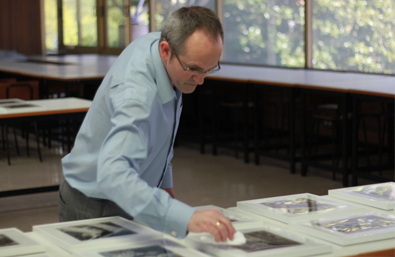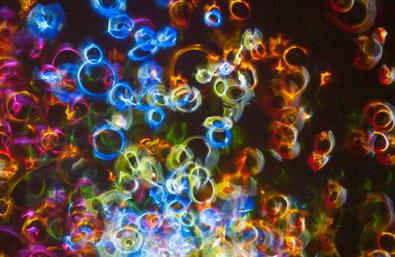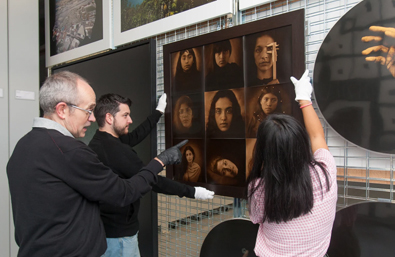

Collection: Policies
CONSERVATION OF THE COLLECTION
The conservation plan follows general guidelines for all the works, including controlled, monitored and stable temperature and RH conditions, smoke detection, fire prevention measures, and regular weekly reviews of the exhibited works by the Museum's conservation team.
These measures are accompanied by a 24-hour physical and video surveillance plan.
The paintings and sculptures are described morphologically after inspection one by one, which allows to establish a report of the condition of the work when it enters the collection. The works are registered in the collection's database where the state of conservation of each piece is recorded.
In the case of photography and depending on the characteristics of the process, type of paper, type of emulsion and state of conservation, the pieces are subjected to physical cleaning and stored in individual Mylar envelopes. Each photograph is entered with a registration number andpreserved in fire-enameled trays or acid-free containers.
When the pieces are catalogued, the conservation conditions of the piece are indicated in a specific field (good, fair or poor). When a work is loaned for an exhibition before it leaves the Museum, a complete condition report is made in which the condition of the work is referenced and it is photographed at high resolution so that its condition is recorded.
The storage conditions are stable and optimal for the stored parts.
The exhibition conditions are between 20 and 22 ºC and 45-50 % RH. The Museum is illuminated with ERCO LEDs, dimmable and free of UV radiation. The power measured in LUX varies from 18-25 lux, with which the calotypes and salt papers are illuminated, 100 lux with which the charcoal emulsions are illuminated, 125 lux with which the prints on cotton with mineral pigments are illuminated up to 150 lux with which the oil paintings are illuminated. Sculptures, depending on the materials, vary from 125 lux to 250 lux.
The Museum is developing a Preventive Conservation Plan that contemplates not only the conservation of the collection but also the protocols for action in certain situations.
This plan is directed by the Curatorial Department, but is developed in collaboration with the rest of the Museum's departments and includes training for room and surveillance personnel to deal with different situations.

CRITERIA AND HISTORICAL EVOLUTION OF COLLECTION GROWTH
This photography collection is a living collection, still growing.
The strategic lines of development of the collection are focused on the one hand on completing research on the development of the photographic technique from its origins to the present day, and on the other hand on promoting contemporary art and creation.
1. Through the program called "Tender puentes"inherited from the Photographic Fund and initiated in 2002, visual artists are invited to develop their own project with the support of those responsible for the collection and the exhibition area. The project is included in the editorial line of the same name.
Since 2016, the performative artists have also had a program of Artistic Residencies inspired by the collection and collected in the collection "Cuadernos de Creación".
The purpose of both programs is to produce contemporary work taking as a starting point the historical pieces preserved in the Museum. Several contemporary authors of national and international prestige have been invited to carry out a personal reflection, a project of their own in dialogue with the key pieces of universal photography contained in the Museum's collection.
International photographers such as Roland Fischer, Lynne Cohen, Gabriele Basilico or Luis González Palma, and national photographers such as Manuel Brazuelo, Jorge Ribalta, María Bleda and José María Rosa, Joan Fontcuberta or Javier Vallhonrat, or Navarrese photographers such as Ángel Fuentes, Carlos Cánovas and Carlos Irijalba, among others, have participated in this program. A total of 35 visual artists and thirteen performative arts artists have participated in these programs to date, enriching the Museum's collection.
In addition to these programs, there are the traditional ways of adding works to the collection by acquiring them on the market, either directly from the artists or from galleries or auction houses. The Museum does not have a fixed annual budget for the purchase of works, but decides on its acquisitions according to the collection's development strategy.
3. The Museum carries out crowdfunding or micro-sponsorship campaigns that allow the acquisition of new pieces.
4. The rest of the artistic incorporations come to the Museum through donations from people linked to art who wish to contribute to the work of research, teaching and dissemination carried out by the institution.

LOAN OF COLLECTIONS
The Museo Universidad de Navarra is an open museum in constant relationship with other national and international art centers.
Since its opening in 2015 it has collaborated by lending its collections to exhibition projects produced by other Museums and Institutions among which we highlight: IVAM, ARTIUM, Museo Esteban Vicente, Museo Bellas Artes de Bilbao, MACBA, CAAM, MNCARS, MNAC, Fondation Cartier pour l'Art Contemporain, Maison de Patrimoine, Hôtel de Sully, Instituto Cervantes, Saint LouisArt Museum , Museo Balenciaga and The Israel Museum.
The requesting institution is asked to submit its facility report and to verify that it meets the environmental, physical and security criteria for the exhibition of the requested pieces. If it does not meet these criteria, the loan is denied. If what has been requested to exhibit are photographs, facsimile reproductions are offered. These reproductions are made under the supervision of the team responsible for the collection and are returned to the Museum after the exhibition.
In turn, the Museum has its own facility report that is provided to institutions that are requested to loan works of art.
The work loans made in each year are included in the corresponding annual report.
A complete list of loans can be found at the bottom of the exhibitions page. The team is working on updating this register in real time through the web page that provides access to the entire collection: coleccionmun.unav.edu, through the Funds and Loans section.
YEAR 2014
2 works by José Ortiz Echagüe for the exhibition "Dries Van Noten". Musée des Arts Décoratifs, Paris. From February 26 to August 31, 2014.
9 works by José Ortiz Echagüe for the exhibition "The apocryphal colony". Museum of Contemporary Art of Castilla y León. From June 20, 2014 to January 5, 2015.
YEAR 2015
10 works by Antonio Arissa for the exhibition "Arissa. L'ombra i el fotògraf, 1922-1936". Centre de Cultura Contemporània de Barcelona. From October 15, 2014 to April 30, 2015.
1 work by José Ortiz Echagüe for the exhibition "En el frente del arte. Ricardo de Orueta 1868-1939". Spanish Cultural Action. From September 16 to December 8, 2014 at Museo Nacional de Escultura, Valladolid / From December 18 to March 8, 2015 in the rooms of MUPAN, Ayuntamiento de Málaga. From March to June 2015 at the Residencia de Estudiantes, Madrid.
2 works by José Ortiz Echagüe for the exhibition "Movimientos y secuencias". Picasso Museum of Málaga. February 2 to May 17, 2015.
22 works by José Ortiz Echagüe for the exhibition "Acercando orillas. Expectation and memory". Apeadero Hall of the Reales Alcázares of Seville. May 29, 2015 to July 20, 2015.
9 works by Pere Formiguera for the exhibition "Pere Formiguera. Ars Photographica". Centre d'Art i Cultura Contemporània. San Cugat del Vallès City Council. March 4 to June 29, 2015.
YEAR 2016
1 work by Gabriel Casas for the exhibition "Gabriel Casas. Photography, information and modernity in Barcelona 1929-1939". Museu Nacional d'Art de Catalunya. April 22 to August 30, 2015. Caixaforum Girona from September 22, 2015 to January 17, 2016. Caixaforum Tarragona from February 9 to May 29, 2016.
9 works by Luis González Palma and 2 by André Disderi for the exhibition "Luis González Palma. Constellations of the intangible". CGAC from November 12, 2015 to March 2016.
16 works by Javier Vallhonrat for the exhibition "Interactions". CGAC. From October 30, 2015 to February 28, 2016.
33 works (Vigier, Beaucorps, Delaunay; 28 facsimiles and 5 originals) for the exhibition "Seville through photography". University of Seville. From March 10 to April 22, 2016.
8 works (Battistuzzi, Frith, Franck, anonymous) for the exhibition "Barcelona. La metròpoli en l' era de la fotografía. 1860-2004". From March 22 to June 26, 2016.
1 work by William Stirling for the exhibition "Copied by the sun". Museo Nacional del Prado. From May 18 to September 4, 2016.
24 works by José Ortiz Echagüe for the exhibition "Coal and velvet. Views on the popular costume of Ortiz Echagüe and Balenciaga", at Museo Cristóbal Balenciaga in Getaria. October 6, 2016 to May 9, 2017.
1 sketchbook, with 63 works, for the exhibition "Una modernidad singular", at Museo de San Telmo San Sebastián. November 4, 2016 to February 26, 2017.
7 works by José Ortiz Echagüe for the permanent exhibition of the Museo Nacional Centro de Arte Reina Sofía (MNCARS) for a period of five years.
2017-18 academic year
Pieces by José Ortiz-Echagüe for the exhibition Región (Los relatos). Landscape change and water politics of the Museo de Arte Contemporáneo de Castilla y León (MUSAC).
Pieces by Ortiz Echagüe for the exhibition Provincia 53. Art, territory and decolonization of the Sahara of the Museo de Arte Contemporáneo de Castilla y León (MUSAC) and the Centro de la Naturaleza (CDAN) of the Fundación Beulas (Huesca).
* The 2018-19 academic year closes on August 31, 2019.